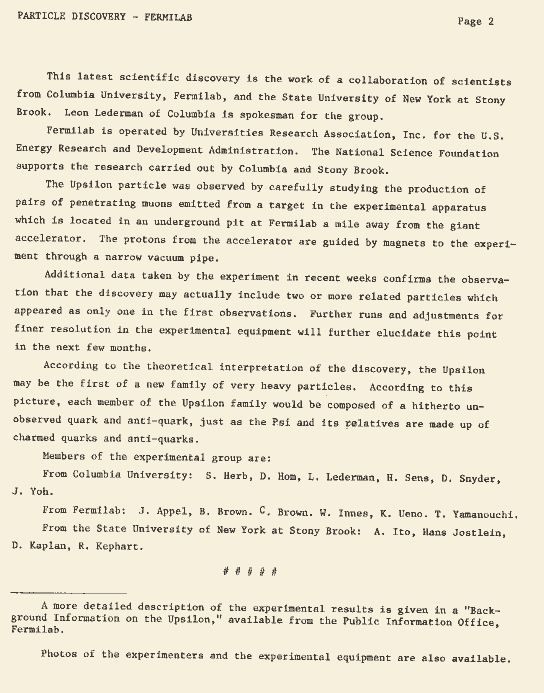Friday August 5, 1977 Press Release Concerning the Upsilon
Text version of this news release on the Fermilab public information website. The full text is also reproduced below the scans on this page.


Text of News Release (August 7, 1977)
77-6
For release a.m., Friday, August 5, 1977
FOR TECHNICAL INFORMATION CALL:
L. Lederman, Columbia University
(914) 591-8100
C. Brown, Fermilab
(312) 840-4096
FOR GENERAL INFORMATION CALL:
M. Pearson, Fermilab
(312) 840-3351
An experimental group at the Fermi National Accelerator Laboratory announced recently that it has discovered a new particle. The new particle has a mass of 9.5 GeV. It is 10 times heavier than the proton and is the heaviest sub-nuclear particle ever seen. The new particle -- which the group has named "Upsilon" -- is interpreted by theorists to be the first hint of a whole new family of subnuclear particles.
The speculation that all matter is made up of small point-line objects called "quarks" has been hotly pursued in research centers all over the world in the past few years. The original theories suggested the existence of three different kinds of quarks. The "J/Psi" particles discovered at the Brookhaven National Laboratory and the Stanford Linear Accelerator Center in 1974 were the first of several discoveries which showed strong evidence of the existence of a fourth kind of quark, the "charmed" quark. It now appears as a result of the work at Fermilab that there may be a fifth quark, still another constituent in the fundamental structure of matter.
This latest scientific discovery is the work of a collaboration of scientists from Columbia University, Fermilab, and the State University of New York at Stony Brook. Leon Lederman of Columbia is spokesman for the group.
Fermilab is operated by Universities Research Association, Inc. for the U.S. Energy Research and Development Administration. The National Science Foundation supports the research carried out by Columbia and Stony Brook.
The Upsilon particle was observed by carefully studying the production of pairs of penetrating muons emitted from a target in the experimental apparatus which is located in an underground pit at Fermilab a mile away from the giant accelerator. The protons from the accelerator are guided by magnets to the experiment through a narrow vacuum pipe.
Additional data taken by the experiment in recent weeks confirms the observation that the discovery may actually include two or more related particles which appeared as only one in the first observations. Further runs and adjustments for finer resolution in the experimental equipment will further elucidate this point in the next few months.
According to the theoretical interpretation of the discovery, the Upsilon may be the first of a new family of very heavy particles. According to this picture, each member of the Upsilon Family would be composed of a hitherto unobserved quark and anti-quark, just as the Psi and its relatives are made up of charmed quarks and anti-quarks.
Members of the experimental group are:
From Columbia University: S. Herb, D. Hom, L. Lederman, H. Sens, D. Snyder, J. Yoh.
From Fermilab: J. Appel, B. Brown, C. Brown, W. Innes, K. Ueno, T. Yamanouchi.
From the State University of New York at Stony Brook: A. Ito, Hans Jostlein, D. Kaplan, R. Kephart.


